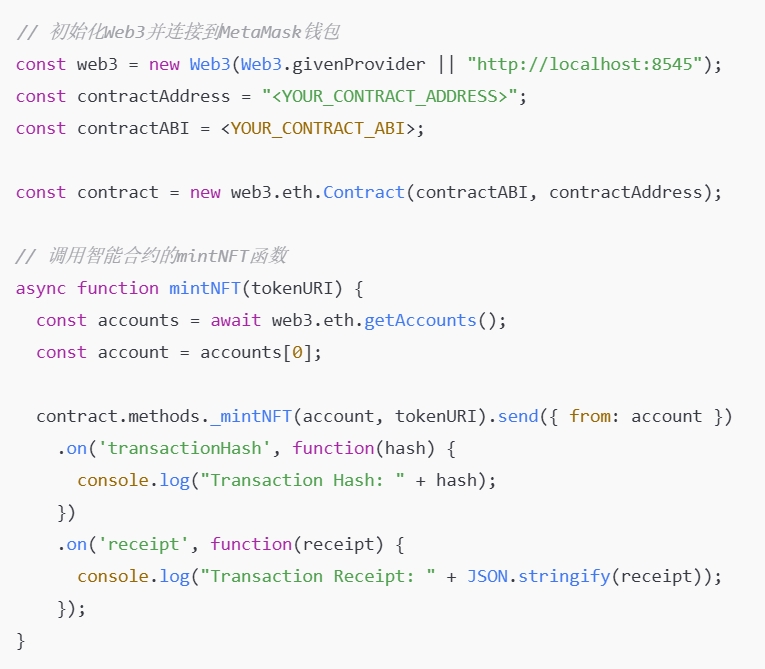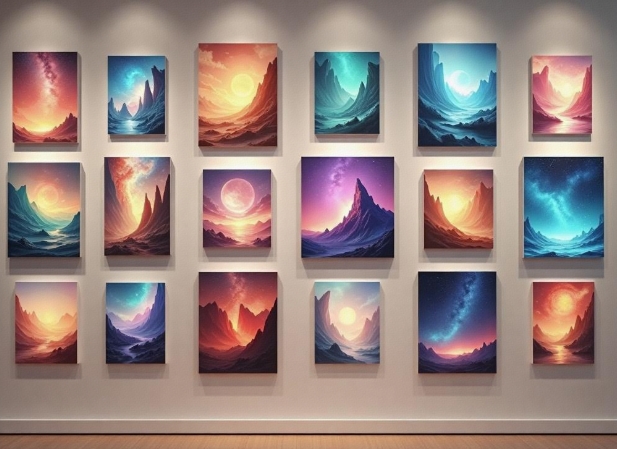DApp and NFT: A Guide to Developing Digital Art and Collectibles
- latest articles
- 1.DApp Development & Customization: Merging Diverse Market Needs with User Experience 2.Analysis of the Core Technical System in DApp Project Development 3.How to achieve cross-chain interoperability in Web3 projects? 4.How does the tokenization of points reconstruct the e-commerce ecosystem? 5.How to Set and Track Data Metrics for a Points Mall? 6.What is DApp Development? Core Concepts and Technical Analysis 7.Inventory of commonly used Web3 development tools and usage tips 8.Development of a Distribution System Integrated with Social E-commerce 9.Six Key Steps for Businesses to Build a Points Mall System 10.What is DApp Development? A Comprehensive Guide from Concept to Implementation
- Popular Articles
- 1.Future Trends and Technology Predictions for APP Development in 2025 2.Analysis of the DeFi Ecosystem: How Developers Can Participate in Decentralized Finance Innovation 3.From Zero to One: How PI Mall Revolutionizes the Traditional E-commerce Model 4.DAPP Development | Best Practices for Professional Customization and Rapid Launch 5.Recommended by the Web3 developer community: the most noteworthy forums and resources 6.From Cloud Computing to Computing Power Leasing: Building a Flexible and Scalable Computing Resource Platform 7.How to Develop a Successful Douyin Mini Program: Technical Architecture and Best Practices 8.Shared Bike System APP: The Convenient Choice in the Era of Smart Travel 9.How to Create a Successful Dating App: From Needs Analysis to User Experience Design 10.From Design to Development: The Complete Process of Bringing an APP Idea to Life
In recent years, decentralized applications (DApps) and non-fungible tokens (NFTs) have become hot topics in the field of blockchain technology. They not only disrupt traditional financial systems but also have a profound impact across various industries such as art, gaming, and collectibles. Particularly in the realm of digital art and collectibles, the emergence of NFTs has brought unprecedented opportunities for artists and collectors. This article will explore how to utilize DApp and NFT technologies to develop digital art and collectibles, providing a detailed development guide.
Part 1: Understanding DApps and NFTs
1.1 What is a DApp?
A decentralized application (DApp) is an application that runs on a blockchain. Unlike traditional applications, DApps do not rely on central servers but operate through smart contracts and decentralized networks on the blockchain. DApps are characterized by transparency, immutability, and decentralization, which give them significant application potential in fields such as art, finance, and gaming.
1.2 What is an NFT?
A non-fungible token (NFT) is a unique digital asset typically used to represent one-of-a-kind items or works, such as digital art, music, videos, and in-game items. Unlike fungible tokens like Bitcoin or Ethereum, each NFT has a unique identifier, making every NFT distinct. This makes NFTs an ideal choice for the art and collectibles sectors, as they ensure the scarcity and uniqueness of digital works.
1.3 The Relationship Between DApps and NFTs
DApps and NFTs are closely related in the development of digital art and collectibles. DApps are often used to build decentralized platforms that allow users to create, trade, and display NFT works. NFTs, as core assets within DApps, utilize smart contracts to ensure the uniqueness, ownership, and transparency of transaction history for the works.
Part 2: The Market for Digital Art and Collectibles
2.1 The Rise of Digital Art
With the maturation of blockchain technology, the digital art market has undergone significant transformation. Artists no longer rely solely on galleries or auction houses to showcase and sell their works; instead, they can directly upload their creations to blockchain platforms via NFTs, ensuring copyright and ownership. Notable digital artworks, such as Beeple's "Everydays: The First 5000 Days," sold for $69 million at Christie's, marking the rise of digital art as an emerging art form.
2.2 Changes in the Collectibles Market
NFTs have not only impacted the digital art space but have also revolutionized the traditional collectibles market. Traditional collectibles like famous paintings, antiques, and stamps require physical space and display, whereas NFTs transform these collectibles into digital assets, enabling collectors to trade globally. Through blockchain, NFTs ensure the authenticity and scarcity of these digital collectibles.
2.3 Trends in the NFT Market
According to market research, the NFT market has experienced explosive growth in recent years. From 2020 to 2021, both trading volume and market participants increased significantly. More artists, brands, and investors are paying attention to and entering the NFT market, driving rapid development in the digital art and collectibles sector.
Part 3: Development Guide for DApps and NFTs
3.1 Development Environment and Tools
To develop a DApp-based NFT platform, the first step is to set up the development environment. Common development tools include:
Solidity: A programming language used to write smart contracts, running on the Ethereum blockchain.
Truffle Suite: A popular development framework providing tools for compiling, deploying, and testing smart contracts.
Web3.js: A JavaScript library for interacting with the Ethereum blockchain.
IPFS: A decentralized file storage protocol used for storing digital artworks of NFTs.
Metamask: An Ethereum wallet plugin that allows users to manage private keys, conduct transactions, and interact with DApps.
3.2 Creating Smart Contracts for NFTs
The core of an NFT is the smart contract, which defines the behavior and attributes of the NFT. A simple NFT can be created by inheriting the ERC721 standard. Each NFT has a unique tokenId and is associated with a URI that points to the metadata of the digital artwork (typically an image, audio, or video file).
3.3 Integration with IPFS
To ensure that the digital works of NFTs are not lost or tampered with, they are typically stored on decentralized storage platforms like IPFS (InterPlanetary File System). When creating an NFT, developers upload the artwork to IPFS and bind the generated URI link to the NFT's smart contract.
3.4 Frontend Development
The frontend is the interface through which users interact with the DApp. Frontend development typically uses HTML, CSS, JavaScript, and frameworks like React or Vue.js. Through the frontend interface, users can browse NFT works, buy or sell NFTs, and interact with smart contracts.
Below is a simple frontend example demonstrating how to use Web3.js to interact with a smart contract:

3.5 Launch and Deployment
After completing the smart contracts, frontend, and IPFS integration, the next step is to launch the DApp. Smart contracts are deployed to the Ethereum mainnet or other compatible blockchain platforms (such as Binance Smart Chain, Polygon, etc.), and the frontend can be hosted on traditional web servers or decentralized storage services.
Part 4: Success Stories and Future Outlook
4.1 Success Stories
As mentioned earlier, Beeple's digital artwork "Everydays: The First 5000 Days" sold for a record-breaking price. Additionally, NFT projects like CryptoPunks and Bored Ape Yacht Club have not only advanced digital art but also opened new horizons for the digital collectibles market.
4.2 Future Outlook
With continuous advancements in blockchain technology and increasing user demand, the prospects for DApps and the NFT market are very broad. In the future, NFTs will not be limited to art and collectibles but will expand into areas such as gaming, virtual reality, and identity verification. As more artists, brands, and developers enter this market, digital art and collectibles will usher in an even more prosperous future.
Conclusion
The combination of DApps and NFTs brings unprecedented opportunities for the development of digital art and collectibles. Through blockchain technology, artists can interact directly with their audience, and collectors can ensure the scarcity and authenticity of digital assets. In the future, with ongoing technological advancements, the world of digital art and collectibles will become even more vibrant and full of endless possibilities.
-

DApp Development & Customization: Merging Diverse Market Needs with User Experience
As blockchain technology matures and becomes more widespread, decentralized appl···
-

Analysis of the Core Technical System in DApp Project Development
With the rapid development of blockchain technology, decentralized applications ···
-

What is DApp Development? Core Concepts and Technical Analysis
With the rapid development of blockchain technology, decentralized applications ···

 Blockchain
Blockchain











